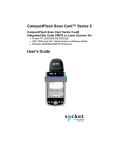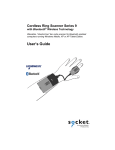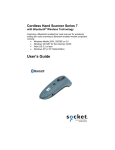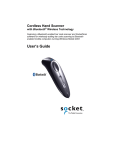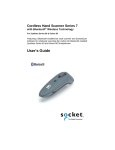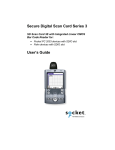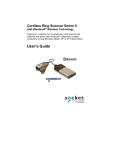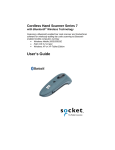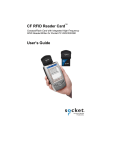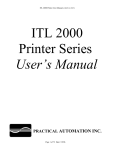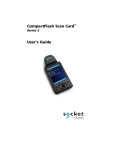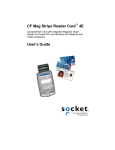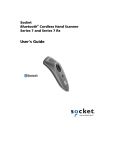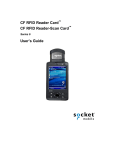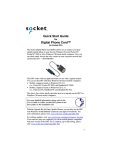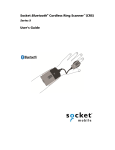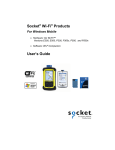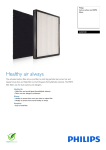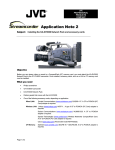Download Socket CF Scan Card User's Guide
Transcript
CompactFlash Scan Card™ Series 5 CompactFlash Scan Card Series 5 with Integrated Bar Code CMOS or Laser Scanner for: • Pocket PC 2000/2002/2003/2003SE • HPC 2000s and Pen Tablets based on Windows Mobile • Windows 98SE/Me/2000/XP Notebooks User’s Guide 8/2005 Document # 6410-00166 J Copyright Notice Copyright © 2005 Socket Communications, Inc. All rights reserved. Socket, the Socket logo and Mobility Friendly are registered trademarks of Socket Communications, Inc. CF Scan Card and SocketScan are trademarks of Socket Communications, Inc. All other brand and product names are trademarks of their respective holders. Reproduction of the contents of this manual without the permission of Socket Communications is expressly prohibited. Please be aware that the products described in this manual may change without notice. Feel free to contact SOCKET COMMUNICATIONS at: Socket Communications, Inc. 37400 Central Court Newark, CA 94560 Other than the above, Socket Communications can assume no responsibility for anything resulting from the application of information contained in this manual. Please refrain from any applications of the Socket CF Scan Card that are not described in this manual. Please refrain from disassembling the CF Scan Card. Disassembly of this device will void the product warranty. You can track new product releases, software updates and technical bulletins by visiting Socket’s web page at: www.socketcom.com. 2 Table of Contents COPYRIGHT NOTICE 2 1 | INTRODUCTION 5 About the Software System Requirements Package Contents Product Registration 2 | SETUP FOR WINDOWS MOBILE STEP 1: Uninstall Other Scanning Software STEP 2: Install the Software STEP 3: Insert the CFSC STEP 4: Start SocketScan STEP 5: Assign a Trigger Button STEP 6: Scan Data into a Windows Program OPTIONAL: Select Symbologies OPTIONAL: Configure Prefix/Suffixes OPTIONAL: Run Scan Demo OPTIONAL: Configure Sounds OPTIONAL: Use SocketScan Trigger OPTIONAL: Configure Special Symbologies 3 | SETUP FOR WINDOWS 98SE/ME/2000/XP STEP 1: Uninstall Other Scanning Software STEP 2: Insert the Installation CD STEP 3: Insert the CFSC STEP 4: Configure for New Hardware STEP 5: Install SocketScan Software STEP 6: Assign a Trigger Button STEP 7: Scan Data into a Windows Program OPTIONAL: Configure Prefix/Suffixes OPTIONAL: Configure Sounds OPTIONAL: Configure Symbologies 5 6 6 6 7 8 9 11 11 12 14 15 16 17 18 19 20 21 22 22 22 23 25 27 28 29 30 31 APPENDICES A | CFSC SPECIFICATIONS 32 B | BAR CODE LABEL SPECIFICATIONS 33 C | CLASS 1 VS. CLASS 2 LASER SCANNERS 34 D | ENABLING OR DISABLING SYMBOLOGIES 37 3 E | DECODE ZONE 39 F | TROUBLESHOOTING 41 G | TECHNICAL SUPPORT 42 LIMITED WARRANTY 43 REGULATORY COMPLIANCE 45 4 1 | Introduction The Socket CompactFlash Scan Card (CFSC) Series 5 gives you the freedom of scanning bar codes anytime anywhere with a variety of Windows-based mobile computers. The card’s compact design lets you scan with only one hand when used with a PDA. The CFSC is sleekly designed with no cables or batteries and is available in three configurations: • CFSC 5E – Entry Level, CMOS • CFSC 5M – Mid-Range, Class 1 Laser • CFSC 5P – Performance, Class 2 Laser See Appendix C for a detailed comparison of the two laser classes. The CFSC Series 5 works in the CompactFlash or PC Card slot of: • Pocket PC 2000/2002/2003/2003SE • HPC 2000 or pen tablet running Windows CE v3.0 or greater • Notebook computer running Windows 98SE, Me, 2000 or XP. About the Software SocketScan™ enters scanned data directly into any open Windows program, as if the data were manually typed. You can configure Prefix/Suffixes and assign a .WAV file to signify good data reads. For Windows Mobile, SocketScan also includes a Symbology Selector and Scan Demo. The Symbology Selector makes it easy to choose the symbologies you want to enable/disable in the scanner. Scan Demo helps you identify the properties of an unfamiliar bar code. For Windows 98SE/Me/2000/XP, SocketScan makes it easy to assign a function key to trigger the scanner. For Windows Mobile, also included is SocketScan Trigger, which places a software trigger on your screen that you can tap to trigger the laser. Installation is optional. For software updates, visit: www.socketcom.com/support/support_bar.asp CHAPTER 1: INTRODUCTION 5 System Requirements Your mobile computer should meet these minimum requirements: • Any of the following operating systems: - Windows Mobile 2003SE, 2003 - Windows CE 3.0 or later - Windows XP, 2000, Me, 98SE • Available CompactFlash or PC Card slot (Operation in a PC Card slot requires a PC Card adapter) If your package does not include a PC Card adapter, you can purchase it separately from Socket’s website, SKU# AC4001-979. Package Contents The CFSC Series 5 package includes: • The CF Scan Card • The SocketScan Installation CD • Booklets with copyright, warranty, and regulatory compliance information The CF Scan Card with PC Card Adapter package includes all of the above plus a Type II CompactFlash-to-PC Card adapter. Product Registration Socket highly recommends that all customers register their products. Registered users receiver priority for technical support, product updates, and special offers. Register online at: www.socketcom.com/prodreg. Please note that product registration is not required to ensure your warranty rights. 6 2 | Setup for Windows Mobile This chapter shows how to install, configure, and use the CF Scan Card (CFSC) on any of the following Windows Mobilebased devices: • Pocket PC 2000/2002/2003/2003SE • HPC 2000 or pen tablet running Windows CE v3.0 or greater This chapter shows Pocket PC 2002 screens. Other Windows Mobile-based devices will have functionally equivalent screens except where otherwise noted. Setup Summary STEP 1: Uninstall other scanning software. STEP 2: Install the software. STEP 3: Insert the CFSC into Your Device. STEP 4: Start SocketScan. STEP 5: Assign a trigger button. STEP 6: Scan data into a Windows program! OPTIONAL: • Select symbologies. • Configure prefix/suffixes. • Run Scan Demo application to scan unknown bar codes. • Configure sounds. • Manually configure symbologies or extensions. CHAPTER 2: SETUP FOR WINDOWS MOBILE 7 STEP 1: Uninstall Other Scanning Software Delete any bar code scanning software you may already have installed on your mobile computer. You can either uninstall the software directly from your mobile computer, or indirectly via ActiveSync. OPTION 1: Uninstall Directly from the Mobile Computer 1. Make sure the bar code scanning software is closed, and remove the CFSC from your mobile computer. 2. Tap Start | Settings. Tap on the System tab or Control Panel. 3. Tap on the Remove Programs icon. 4. Select the bar code scanning software, then tap Remove. 5. Tap Yes to confirm removal of the program. OPTION 2: Uninstall via ActiveSync 1. Make sure the bar code scanning software is closed, and remove the CFSC from your mobile computer. 2. Use ActiveSync and a serial/Ethernet/USB cable or cradle to make an active connection between your mobile computer and a host PC. 3. On the host PC, open Microsoft ActiveSync. 4. Click Tools | Add/Remove Programs. 5. Select the bar code scanning software and click Remove. 6. In the confirmation screen, click OK. 7. The next dialog will ask if you want to remove the software from your host PC as well. • Click NO to keep a copy of the software on the host PC that can later be re-installed onto a mobile computer. • Click YES to remove the software from the host PC. 8 STEP 2: Install the Software 1. Use ActiveSync and a serial/Ethernet/USB cable or cradle to make an active connection between the mobile computer and a host PC. 2. Insert the installation CD into your host PC. 3. Use My Computer or Windows Explorer to access your CD-ROM drive. In the CD, click on SETUP.EXE. 4. Follow the instructions on your screen to install the software for Windows CE (also compatible with Windows Mobile 2003). • Read the information in the welcome screen and click next. • In the Main Page, click Install Software. • In the Installation screen, click Windows CE. CHAPTER 2: SETUP FOR WINDOWS MOBILE 9 5. In the File Download screen, select the option that lets you run the file from its current location. IMPORTANT! YOU MUST RUN THE FILE! DO NOT SAVE! 6. If a security warning screen appears, click Run. 7. The installation wizard will begin. Follow the instructions that appear on your screen until installation is complete. 8. When software installation is complete, disconnect the mobile computer from the host PC. Soft reset the mobile computer by pressing the reset button. IMPORTANT! BE SURE TO SOFT RESET YOUR MOBILE COMPUTER! 10 STEP 3: Insert the CFSC Plug directly into a CompactFlash slot. OR Insert into an adapter, then plug the combined unit into a PC Card slot. STEP 4: Start SocketScan 1. Pocket PC: Tap Start | Programs | SocketScan. HPC: Tap on the SocketScan icon on your desktop. 2. Whenever SocketScan is running, either of two icons may appear in the menu bar (visible from the Today screen for Pocket PCs). Make sure the “CF Scan Card detected” icon appears. Icon Meaning. CF Scan Card detected. SocketScan detects the scanner and is ready to scan. No scanner detected. The scanner is either missing or improperly inserted. CHAPTER 2: SETUP FOR WINDOWS MOBILE 11 STEP 5: Assign a Trigger Button Follow the appropriate directions for your device and refer to your device’s user documentation to assign a trigger button for the CF Scan Card. Note: • If SocketScan is not running yet, then pressing the assigned trigger button is a quick way to launch SocketScan. Pressing the trigger button will fire the laser only when SocketScan is open. • If it is inconvenient or impossible for you to assign a hardware button on your device, you can install SocketScan Trigger from the installation CD to place a software trigger button on your screen. Pocket PC These instructions are for a Pocket PC 2000/2002/2003/2003SE. 1. Go to Start | Settings | Personal | Buttons. 2. From the Button list, select a button to trigger the CF Scan Card. In the Button assignment field, select SocketScan. When done, tap ok. Note: For maximum ergonomic placement, choose a button located directly beneath your thumb or forefinger when you hold the Pocket PC. The Voice Record button is a good choice for many Pocket PCs. 12 HPC 2000 or Pen Tablet These instructions were based on a HP Jornada 720 Handheld PC 2000. The procedure for assigning a trigger key can vary from device to device. Consult your device’s user documentation if necessary. 1. Tap Start | Settings | Control Panel | HP hot keys: 2. The HP hot keys Properties screen will appear. Under the Assign to: field, tap on the Browse button. 3. In the screen that appears, select SocketScan. Tap OK. 4. After SocketScan appears in the Assign to: field, tap OK. CHAPTER 2: SETUP FOR WINDOWS MOBILE 13 STEP 6: Scan Data into a Windows Program 1. Start the Windows application that you want to receive the data (e.g., Excel, Notepad, etc.). Make sure a document or spreadsheet is open. Note: For information about bar code scanning applications, email [email protected] 2. Press the assigned trigger button and scan the code. For example, try this bar code: Important! Do not look directly into the beam or point it at a person! When data is read, a beep should sound, the laser should turn off, indicating a good read. If the CFSC fails to read data within a few seconds, the laser beam will turn off, and you must try again. 3. After a successful scan, data should appear in your document. For example, after you scan the code above into a Pocket Excel spreadsheet, data should appear in the first cell. Note: If your mobile computer enters sleep mode when SocketScan is running, press the ON button to restart SocketScan and initialize the scanner. 14 OPTIONAL: Select Symbologies The applet makes it quick and convenient to modify which symbologies you want the scanner to recognize. By default, the scanner is set to recognize nine of the most common symbologies. 1. Tap on the SocketScan icon. In the pop-up menu, tap Symbology Selector... 2. In the screen that appears, check the symbologies you wish to enable. Uncheck those you wish to disable. Tap ok. Note: 1. Symbologies not supported by the CFSC will be grayed out. 2. Enabling all possible symbologies will make the decode process slightly longer. CHAPTER 2: SETUP FOR WINDOWS MOBILE 15 OPTIONAL: Configure Prefix/Suffixes The SocketScan applet lets you specify prefix and/or suffix characters to be added automatically to the data you scan. This helps to further eliminate manual data entry. 1. Tap on the SocketScan icon. In the pop-up menu, tap Prefix/Suffix. Note: You can configure prefix/suffixes whether or not the CFSC is connected to your mobile computer. 2. In the pop-up menu, select Prefix/Suffix... 3. In the screen that appears, enter the characters you want to be appended to each scan (128 character maximum). Tap ok. Note: Only printable ASCII characters can be used as prefixes or suffixes. Note: The default suffix is a carriage return. 16 OPTIONAL: Run Scan Demo Scan Demo makes it easy to determine the symbology, number of characters, and decoded data (in either ASCII or Hex) of any bar code supported by the scanner. This is especially useful if you encounter a bar code that the scanner will not decode by default. 1. Tap on the SocketScan icon. In the pop-up menu, tap Scan Demo. This will close SocketScan and open Scan Demo as a separate application. 2. The Scan Demo screen will appear. If desired, use the check boxes at the bottom of the screen to modify the test. • Enable all symbologies: By default, this option is checked. Different symbologies can sometimes interpret the same bar code differently, so you may want to uncheck this option. • Display as hex data: Check this box to view scanned data in hexadecimal format. Otherwise, data will appear as ASCII. 3. Scan the bar code. 4. Scan Demo will report properties of the bar code you scan. CHAPTER 2: SETUP FOR WINDOWS MOBILE 17 OPTIONAL: Configure Sounds The SocketScan Sounds applet lets you choose any WAV sound file to be played to indicate a successful scan. 1. Tap on the CFSC icon in the menu bar in the Today screen for Pocket PCs). to launch the applet (visible 2. In the pop-up menu, select Sounds... 3. In the screen that appears, select a sound for indicating successful scans. Tap ok. Browse box To you want to play a .WAV file, after selecting Play .wav file, you can search through files by tapping the browse box. In the Open screen, tap on the file you want: Note: For Pocket PCs, you can only select a WAV file from the My Documents folder. If needed, copy the file you need to this folder. 18 OPTIONAL: Use SocketScan Trigger If you find it inconvenient or impossible to assign or use a hardware button to trigger the scanner, you can install this virtual trigger button that “floats” on top of the active application. 1. Make sure to do all of the following before using SocketScan Trigger: • Install SocketScan Trigger from the installation CD. The software must be installed separately from SocketScan. • Start SocketScan. Tap Start | Programs | SocketScan. • Insert the CF Scan Card into your Pocket PC. • Open the application that you want to scan data into. 2. Start SocketScan Trigger. Tap Start | Programs | SocketScan Trigger. 3. The floating trigger button will appear on your screen on top of the active application. Drag from the title bar to move the trigger button to a convenient place on the screen. Tap the trigger button to activate the scanner. CHAPTER 2: SETUP FOR WINDOWS MOBILE 19 4. A SocketScan Trigger icon will also appear in the menu bar of the Today screen. Tap this icon to open a pop-up menu with the following options: • Tap Scan Now to activate the scanner as if you had tapped the trigger button. • Tap Remove Floating Trigger to remove the trigger button from the screen but keep the icon handy on the task bar. To restore the trigger button, tap on the menu bar icon. In the pop-up menu, tap Launch Floating Trigger. • Tap About to view SocketScan Trigger version information. • Tap Close SocketScan Trigger to close the application completely. From this state, the SocketScan trigger can only be launched from the Programs page. OPTIONAL: Configure Special Symbologies In addition to the eighteen symbologies supported by the Symbology Selector, you can also manually configure the CFSC to accept or ignore specialized bar code symbologies, extensions, and parameters. See Appendix D, “Default Parameters,” to see parameter numbers and default settings of each symbology. Also please refer to the Symbol 923 Programming Guide Chapter 5 for CF Scan, available online at: www.socketcom.com/support/support_bar.asp 20 3 | Setup for Windows 98SE/Me/2000/XP This chapter explains how to install the CF Scan Card on a notebook computer running any of the following Windows versions: • Windows 98 Second Edition • Windows Me, 2000 or XP This chapter features screen images from Windows 98SE. Other Windows versions will have functionally equivalent screens except where otherwise noted. Note: The CFSC does NOT work with Windows NT. Setup Summary STEP 1: Uninstall other scanning software. STEP 2: Insert the installation CD. STEP 3: Insert the CFSC. STEP 4: Configure Windows for new hardware. STEP 5: Install SocketScan software. STEP 6: Assign a trigger button. STEP 7: Scan data into a Windows program. OPTIONAL: Configure prefix/suffixes OPTIONAL: Configure sounds. OPTIONAL: Configure SocketScan for specific symbologies or extensions. CHAPTER 3: SETUP FOR WINDOWS 98SE/ME/2000/XP 21 STEP 1: Uninstall Other Scanning Software Delete any bar code scanning software you may already have installed on your mobile computer. 1. Go to Start | Settings | Control Panel | Add or Remove Programs. 2. Select the bar code scanning program and click Remove. 3. Follow the instructions on your screen until the program is removed. STEP 2: Insert the Installation CD Insert the SocketScan Installation CD into your CD-ROM drive. STEP 3: Insert the CFSC 1. Windows 2000/XP: Make sure you are logged on as the Administrator or on an account that has Administrative rights. 2. Insert the CFSC into a CompactFlash-to-PC Card adapter, then plug the combined unit into your computer’s PC Card slot. 3. Windows 2000/XP: After you insert the CFSC, a screen may appear reporting Digital Signature Not Found. Click Yes. 22 STEP 4: Configure for New Hardware The first time you insert the CFSC, a new hardware or device driver wizard will appear. Make sure the installation CD is inside your computer. Windows XP • In the first screen, select Install from a list or specific location. Click Next>. • In the next screen, select Include the location in the search and browse to your CD drive. Click Next>. Note: If a screen reports that the product has not passed Windows logo testing, ignore and click Continue Anyway. • Follow the remaining instructions until installation is complete. Windows 2000 • In the second screen, select Search for a suitable driver for my device. • Check Specify a location. Click Next>. Browse to the CD drive. Click OK. • Follow the remaining screens until the drivers are installed. CHAPTER 3: SETUP FOR WINDOWS 98SE/ME/2000/XP 23 Windows Me • Select Specify the location of the driver. WARNING! FOR WINDOWS Me, DO NOT SELECT Automatic search for a new driver! • In the next screen, select Search for the best driver for your device, and check Removable Media. Click Next>. • Follow the remaining screens until installation is complete. Windows 98SE • The first screen will introduce the wizard. Click Next>. • Select Search for the best driver for your device. Click Next>. • In the next screen, check CD-ROM drive. Click Next>. • Follow the remaining screens until the drivers are installed. 24 STEP 5: Install SocketScan Software 1. Make sure the SocketScan Installation CD is still inside your computer. 2. Use My Computer or Windows Explorer to access your CD-ROM drive. In the CD, click on SETUP.EXE. 3. Follow the instructions on the host PC screen to install the software for your Windows version. 4. In the File Download screen, select the option that lets you run the file from its current location. IMPORTANT! YOU MUST RUN THE FILE! DO NOT SAVE! CHAPTER 3: SETUP FOR WINDOWS 98SE/ME/2000/XP 25 9. If a security warning screen appears, click Run. 10. The installation wizard will begin. Follow the instructions that appear on your screen until installation is complete. 5. Restart your computer. 26 STEP 6: Assign a Trigger Button 1. Start SocketScan. Go to Start | Programs | SocketScan. 3. Whenever SocketScan is running, either of two icons may appear in the task tray at the bottom of your screen. Make sure the “CF Scan Card detected” icon appears. Icon Meaning. CF Scan Card detected. SocketScan detects the scanner and is ready to scan. No scanner detected. The scanner is either missing or improperly inserted. 2. Right-click the icon. In the pop-up menu, click Settings… 3. Select a function key for the trigger button. Click OK. Important! Do not select a key used by another program! Note: If SocketScan is not running yet, then pressing the trigger button is a quick way to launch SocketScan. Pressing the trigger button will fire the laser only when SocketScan is open. CHAPTER 3: SETUP FOR WINDOWS 98SE/ME/2000/XP 27 STEP 7: Scan Data into a Windows Program For information about bar code scanning applications (available separately), email [email protected] 1. Start the Windows application you want to receive the data, such as Notepad, Word or Excel. Make sure a new document or spreadsheet is open that you can scan data into. 2. Press the assigned trigger button and scan the code. For example, try this Code 39 bar code: Important! Do not look directly into the beam or point it at a person! 3. When data is read, a beep should sound, the laser should turn off indicating a good read. If the CFSC fails to read data within a few seconds, the laser beam will turn off, and you must try again. 4. After a successful scan, data should appear in your document. If you scan the code above into an Excel spreadsheet, data should appear in the first cell: 28 OPTIONAL: Configure Prefix/Suffixes The SocketScan applet lets you specify prefix and suffix characters or functions to be added automatically to the data that you scan. 1. Right-click on the SocketScan icon your screen. in the task tray at the bottom of 2. In the pop-up menu, select Settings… 3. Start the applet. In SocketScan Settings, click on the Prefix/Suffix tab. 4. In the Prefix and Suffix fields, enter the characters you want to be appended to each scan (128 character maximum). Click OK. Note: Only printable ASCII characters can be used as prefixes or suffixes. CHAPTER 3: SETUP FOR WINDOWS 98SE/ME/2000/XP 29 OPTIONAL: Configure Sounds The SocketScan applet lets you choose any WAV sound file to be played to indicate a successful scan. 1. 2. Tap on the CFSC icon in the task tray. In the pop-up menu, select Settings. Click on the Sound tab. Select a sound for indicating successful scans, then click OK. To you want to play a .WAV file, after selecting Play .wav file, you can search through files by tapping the Browse button. In the Select a WAV file screen, select the file you want, then click on the Open button: 30 OPTIONAL: Configure Symbologies You can manually configure the CFSC to accept or ignore certain bar code symbologies and extensions. Check Appendix B, “Default Parameters,” to see if the CFSC is already configured for the symbology you need. Default symbologies include Code 39, Code 128, UPC/EAN, MSI Plessey, Code 93 and Codabar. To reconfigure your CFSC for different symbologies, please refer to Symbol 923 Programming Guide Chapter 5 for CF Scan at: www.socketcom.com/support/support_bar.asp CHAPTER 3: SETUP FOR WINDOWS 98SE/ME/2000/XP 31 Appendix A CFSC Specifications Physical Characteristics: CompactFlash Card Size: 1.77 x 1.68 x 0.13 in (45 x 42.8 x 3.3 mm) Laser Scanner Size: 1.97 x 1.45 x 0.83 in (36.8 x 50 x 21 mm) Total Weight: approx. 1.8 oz (51.5 g) CFSC Power Consumption with Class 1 or Class 2 Laser (3.3V supply): Idle: 4 mA (13 mW) Scanning: 75 mA (248 mW) (Also operates on 5V supply) Operating System Support: Windows Mobile 2003/2003SE Windows CE v3.0 or later for Pocket PC 2000/2002, HPC 2000 Windows 98 Second Edition, Me, 2000, and XP Compatibility: Windows or MS-DOS COM port Default Bar Code Symbologies Automatically Detected: Code 39, UPC/EAN, Code 128, and Interleaved 2 of 5. Other symbologies can be easily enabled Laser Scanner Performance: Scan Repetition Rate: 39 (± 3) scans/sec (bidirectional) Decode Distances: 2.2 to 60.0 in (dependent on symbol density, symbology, W-N Ratio, label media, and scan angle) Scan Angle: 53° typical Interface Standards: CompactFlash CF, Type I Extended CompactFlash Spec. 2.0 PC Card (with CompactFlash-to-PC Card adapter) Certification: FCC: Part 15, Class B, CE: EN55024:1998, C-TICK s.182 Software: Universal Installer, configuration utility and virtual keyboard wedge for Windows 32 | APPENDIX A: CFSC SPECIFICATIONS Appendix B Bar Code Label Specifications All bar code symbols/labels should satisfy the appropriate AIM Uniform Symbology Specification. Background Substrate: The bar code symbol should be printed on material (media) that is reflective and has a matte (not glossy) finish. A background diffuse reflectance of at least 70% to 80% is desirable for optimum contrast. Retro-reflective media should be used to obtain decode distances greater than 36 inches. Ink Color and Type: The inked bars should not exceed 25% reflectance at the wavelength that is being used for reading, whether printed with black ink or colored ink. The reflectance value should not vary more than 5% within the same character. Voids and Specks: The code should be printed clearly, free of voids, specks, blemishes and lines that could “fool” the scanner. Specks or blemishes in the white spaces, or false or missing bar sections could be interpreted by the reading equipment as part of the code. Generally, the width of such flaws is more serious than the height. Code symbols/ labels should be rejected if these defects are present. Definition: The bars in the bar code symbol should be well defined. Their edges should not be rough or fuzzy, so that the bars and spaces have the proper widths intended for the bar code symbology used. Contrast: Background reflectance (that of the substrate on which the codes are printed) should always provide a good contrast relative to the ink reflectance (that of the code bars). The difference between the two should be at least 37.5% at the wavelength used for reading. Tolerance: The ratio of the widths of bars and spaces in a bar code symbol must conform to the appropriate AIM bar code specifications and can cause problems if not correct throughout the bar code. Problems can occur when bar edges are smeared or rough, or when they exhibit voids. APPENDIX B: BAR CODE LABEL SPECIFICATIONS | 33 Appendix C Class 1 vs. Class 2 Laser Scanners This is a paper on bar code laser scanners that Jack Brandon, Product Marketing Manager of Scanner Products for Socket Communications, published in September 2001. You can download a copy of this paper from: www.socketcom.com/support/learn.asp Introduction Socket now offers the popular CF Scan Card (CFSC) with either a CMOS, Class 1 or Class 2 laser engine. This document describes the differences between the Class 1 and Class 2 devices and the appropriate applications for each. The primary difference is the power output of the laser. The Class 1 laser has a nominal power output of 0.5 milliwatts, while the output of the Class 2 laser is 1.2 milliwatts. This difference impacts the scanning performance of the device in three ways: 1. Distance — For scanning distances of up to 10 inches, there is very little difference in the ability of either the Class 1 or the Class 2 laser to scan a given bar code. Beyond 10 inches, the Class 2 laser will scan a standard, high quality bar code about 20% - 25% farther than the Class 1 laser. Scanning a standard bar code of any size at a distance greater than 25 inches becomes difficult with the Class 1 laser, while the Class 2 laser will easily scan very large bar codes at 60 inches and beyond. There are a many variables involved in determining the distance at which a bar code can be scanned, including: a. The size of the bar code — The width of the narrowest bar in thousandths of an inch (or ‘mils’) is referred to as the “X dimension” or “size” of a bar code. Standard retail UPC or EAN bar codes are 10 mils (0.010 inches). Larger bar codes, such as warehouse location bar codes, can be 200 mils or larger. The larger a bar code, the greater the distance from which it can be scanned. Please refer to the Decode Zone charts in Appendix E for more detailed information on the relationship between the size of a bar code and the distance at which it can be scanned. 34 | APPENDIX C: BAR CODE LABEL SPECIFICATIONS b. The label media — The media is the material a bar code is printed on. This is usually some type of paper but can also be a plastic or even metallic material. Because the reading mechanism in a bar code scanner is based on contrast, the whiter and more reflecting a media is, the farther away it can be scanned. Retro-reflective media (like a stop sign) is used for scanning very large bar code labels at distances of 20 feet and more. c. The bar code symbology — There are many different bar code symbologies (or ‘languages’), such as UPC, EAN, Code 39, Code 128, Code 93 and more. Some symbologies are easier to decode than others and can, therefore, be scanned at greater distances. 2. Packaging or covering materials — The Class 2 laser can more effectively scan through difficult packaging materials such as Mylar (used for electronic components) or thick plastic or glass such as automobile windshields. 3. Ambient light — The Class 2 laser can more effectively scan in high ambient light conditions such as high intensity lighting or even daylight (indirect sunlight). Scanning bar codes in direct sunlight is extremely difficult because sunlight contains enough energy in the red spectrum used by the laser to ‘blind’ the scanner’s decode system. The second difference between the Class 1 and Class 2 lasers in the Socket CF Scan Card is the wavelength frequency of the laser beam. The Class 1 laser has a 670 nanometer (nm) beam common in most laser bar code scanners, while the Class 2 features a 650nm beam. There is no difference in the scanning capability of the two frequencies, but the 650nm beam is more visible to the human eye, making it appear brighter than the Class 1 laser. The user must see the oscillating laser beam in order to aim it effectively at the bar code to be scanned. The Class 2, 650nm laser is easier to see and aim than the Class 1 laser, especially when scanning at greater distances, through difficult materials or in high ambient light. A third difference between the Class 1 and Class 2 lasers is the current demand during scanning. At 3.3 Volt power (standard for CompactFlash card slots) the Class 1 laser draws about 67 milliamps (mA) and the Class 2 laser draws about 75mA. Both lasers draw about 3 - 4mA when idle. Therefore, for a given level of scanning activity, using the Class 1 laser should result in a slightly longer battery life. A final consideration in the selection of either a Class 1 or Class 2 laser is safety. Staring directly into any laser beam for an extended period of time APPENDIX C: BAR CODE LABEL SPECIFICATIONS | 35 will cause damage to the eyes of humans and animals. The normal use of a bar code scanner is inherently very safe because (a) the laser is typically aimed away from the person using the scanner, and (b) the beam oscillates 39 times per second over a 53 degree arc, making it impossible to stare into the beam. Additionally, using the lower powered Class 1 laser makes it even less likely that eye damage will occur. There are certain organizations in Europe, in fact, that require a Class 1 laser in bar code scanners to meet more stringent safety standards. The Socket CF Scan Card with Class 1 laser meets these European safety standards. Please refer to the Regulatory Compliance section at the end of this User’s Guide for more detailed safety information. Conclusion The Class 1 laser is suitable for most applications with expected scanning distances of less than 20 inches and normal ambient light conditions. The Class 1 laser may be required by certain European organizations to meet more stringent safety standards. When an application is likely to require more demanding scanning capabilities, the Class 2 laser provides the assurance of maximum scanning performance. Note: People who use portable computers to gather and manage data at the point of activity are typically very quick to learn how to use a laser bar code scanner and realize the resulting gains in productivity. They are easily discouraged, however, if time and effort are required to obtain a successful scan – thus the decline in popularity of the much less expensive bar code contact wands seen at most retail checkout counters during the 1980’s. The higher cost of the Class 2 version of the CF Scan Card is easily justified if the application requires higher scanning performance. 36 | APPENDIX C: BAR CODE LABEL SPECIFICATIONS Appendix D Enabling or Disabling Symbologies All Socket bar code scanning products are pre-set to automatically detect and decode (autodiscriminate) the most common bar code symbologies. Refer to the table on the next page to determine which symbologies and parameters are set as default. If you would like to change your symbology settings, you can choose from either of two options, depending on what device you are using and what settings you want to change. Note: • With more symbologies enabled, the scanner must work harder to search through all the possible combinations. This may make the decoding process slightly longer. • Code 39 Full ASCII and Trioptic Code 39 should not be enabled simultaneously. OPTION 1: Symbology Selector for Windows Mobile If you are using a Windows Mobile-based device, you can quickly enable and disable any of the seventeen most popular symbologies by using the SocketScan Symbology Selector. Refer to Chapter 2 for instructions. Note: The length of some symbologies will change after Symbology Selector is used. Refer to the table on the next page. OPTION 2: Scan Programming Bar Codes If you are not using a Windows CE device, and/or if you want to modify an option not included in Symbology Selector, you can scan programming bar codes to configure your CFSC. There are a variety of programming bar codes available that let you enable/disable symbologies as well as configure special features (e.g., specify bar code lengths, transmit check digits, recognize supplementals, etc.). To obtain the programming bar codes, download the Programming Guide online from www.socketcom.com/support/support_bar.asp. Warning! When scanning programming bar codes with the CF Scan Card, do not scan any bar codes that set communication protocols, as the CFSC will be disabled and must be returned to Socket for reprogramming. APPENDIX D: ENABLING/DISABLING SYMBOLOGIES | 37 Table 1. Default Symbologies and Settings of the CF Scan Card Symbology UPC-A UPC-E UPC-E1 EAN-8 EAN-13 • Supplementals • Transmit Check Digit Bookland EAN Code 128 - All Code 39 Trioptic Code 39 Code 39 Full ASCII • Transmit Check Digit Code 93 Interleaved 2 of 5* • Transmit Check Digit Discrete 2 of 5* Codabar MSI Plessey* • Transmit Check Digit CFSC Default Enabled Enabled Disabled Enabled Enabled Disabled Enabled Disabled Enabled Enabled Disabled Disabled Disabled Disabled Enabled Disabled Disabled Disabled Disabled Disabled CFSC Length N/A N/A N/A N/A N/A N/A N/A N/A Any 2 to 55 2 to 55 2 to 55 N/A 4 to 55 14 Only N/A 12 Only 5 to 55 6 to 55 N/A Length with Symbology Selector N/A N/A N/A N/A N/A N/A N/A N/A Any 2 to 55 2 to 55 2 to 55 N/A 2 to 55 2 to 55 N/A 2 to 55 2 to 55 2 to 55 N/A *Warning: Setting the length to “Any” may lead to inaccurate decodes in these symbologies For more information on bar codes, symbologies, labels or other bar code related topics, visit any of the following web sites: a. b. c. d. e. f. g. h. i. j. www.aimglobal.org/technologies/barcode/ www.aimglobal.org/aimstore/stackedsymbologies.htm www.adams1.com www.bizfonts.com www.barcode-us.com/info_center/upc.htm (UPC Codes) www.barcode-us.com/info_center/bookinfo.htm (Bookland EAN) www.dataid.com/bcsymbology.htm www.aaabarcodes.com www.snx.com/mechanics.html www.idautomation.com/barcoding4beginners.html 38 | APPENDIX D: ENABLING/DISABLING SYMBOLOGIES Appendix E Decode Zone The decode zones for the Class 1 and Class 2 lasers in the CF Scan Card are shown below. The minimum element width (“X Dimension” or bar code “size”) is the width in thousandths of an inch (mils) of the narrowest element (bar or space) in the symbol. The figures shown are the typical scanning distances (depths of field) for selected bar code sizes. The maximum usable length of a bar code symbol (Width of Field) at any given range is also shown below. Class 1 Laser Decode Zone APPENDIX E: DECODE ZONE | 39 Class 2 Laser Decode Zone 40 | APPENDIX E: DECODE ZONE Appendix F Troubleshooting For help on SocketScan on a Windows Mobile-based device, tap Start | Help. SYMPTOM: I get the “No Card Detected” icon in the task tray and can’t trigger the laser or scan any bar codes. POSSIBLE REASON Your mobile computer does not recognize the CFSC. SOLUTION Make sure the CFSC is inserted properly. If necessary, remove and reinsert. If using battery power, be sure to tap Yes if asked if you want to use battery power. SYMPTOM: When I try to scan, the laser fires, but no data appears on my screen, and the laser eventually shuts off. POSSIBLE REASON The laser beam is too close or too far from the bar code. The bar code is incorrectly formatted or poorly printed. The bar code symbology may be disabled in the CFSC configuration. SOLUTION Practice so you get accustomed the most effective distance and scanning angle. Try scanning a bar code that is correctly formatted or printed well, such as on a retail package. Use Scan Demo to determine the symbology. If needed, reconfigure the CFSC. SYMPTOM: When I press the trigger button, nothing happens. POSSIBLE REASON You programmed the trigger button incorrectly. SOLUTION Test the button by assigning a different program to it and make sure it works properly. APPENDIX F: TROUBLESHOOTING | 41 Appendix G Technical Support If you have trouble installing or using CF Scan Card, Socket has two technical support resources to help you. Please note that technical support is available in English only. 1. Socket On-Demand Support (SOS) Socket On-Demand Support is an interactive technical support program that focuses in on your specific problem to provide the answers you need. SOS provides immediate service and is the best place to start for technical support. To access SOS, visit: www.socketcom.com/support. Click on the SOS icon. If SOS cannot solve your problem, end the session by submitting an email inquiry to a Socket technical support engineer as prompted. Your interactive session will be saved for reference. 2. Live Technical Support IMPORTANT! To obtain technical support, you must first register your product online at www.socketcom.com/prodreg. After you register your product, log in, click on the Technical Support tab, and click New Trouble Ticket. Follow the online process to submit an email request for technical support. If we are unable to resolve your support inquiry via email, we can arrange for a technical support representative to call you at a specific time. Please refrain from disassembling the CF Scan Card. Disassembly of this device will void the product warranty. 42 | APPENDIX G: TECHNICAL SUPPORT Limited Warranty Socket Communications Incorporated (Socket) warrants this product against defects in material and workmanship, under normal use and service, for the following period from the date of purchase: CF Scan Card: Three years Incompatibility is not a defect covered by Socket’s warranty. During the warranty period, Socket will, at its option, repair or replace the defective product at no charge when furnished with proof of retail purchase, provided that you deliver the product to Socket or to an authorized Socket Service Center. The returned product must be accompanied by a return material authorization (RMA) number issued by Socket or by Socket's Authorized Service Center. If you ship the product, you must use the original container or equivalent and you must pay the shipping charges to Socket. Socket will pay shipping charges back to any location in the contiguous United States. This warranty applies only to the original retail purchaser and is not transferable. Socket may, at its option, replace or repair the product with new or reconditioned parts and the returned product becomes Socket's property. Socket warrants the repaired or replaced products to be free from defects in material or workmanship for ninety (90) days after the return shipping date, or for the duration of the original warranty period, whichever is greater. This warranty does not cover the replacement of products damaged by abuse, accident, misuse or misapplication, nor as a result of service or modification other than by Socket. SOCKET IS NOT RESPONSIBLE FOR INCIDENTAL OR CONSEQUENTIAL DAMAGES RESULTING FROM BREACH OF ANY EXPRESS OR IMPLIED WARRANTY, INCLUDING DAMAGE TO PROPERTY AND, TO THE EXTENT PERMITTED BY LAW, DAMAGES FOR PERSONAL INJURY. THIS WARRANTY IS IN LIEU OF ALL OTHER WARRANTIES INCLUDING IMPLIED WARRANTIES OF MERCHANTABILITY AND FITNESS FOR A PARTICULAR PURPOSE. Some states do not allow limitation of implied warranties, or the exclusion or limitation of incidental or consequential damages, so that the above limitations or exclusions may not apply to you. This warranty gives you specific legal rights and you may also have other rights which vary from state to state. This product may contain fully tested, recycled parts, warranted as if new. For warranty information, phone (510) 744-2700. 43 Limited Software Warranty LIMITED WARRANTY. SOCKET warrants that the original disk or CD ROM is free from defects for 90 days from the date of delivery of the SOFTWARE. CUSTOMER REMEDIES. SOCKET’S entire liability and your exclusive remedy shall be, at SOCKET’S option, either (a) return of the price paid or (b) replacement of the SOFTWARE which does not meet SOCKET’S Limited Warranty and which is returned to SOCKET with a copy of your receipt. Any replacement SOFTWARE will be warranted for the remainder of the original warranty period or 30 days, whichever is longer. THESE REMEDIES ARE NOT AVAILABLE OUTSIDE OF THE UNITED STATES OF AMERICA. NO OTHER WARRANTIES. SOCKET disclaims all other warranties, either express or implied, including but not limited to implied warranties of merchantability and fitness for a particular purpose, with respect to the SOFTWARE and the accompanying written materials. This limited warranty gives you specific legal rights. You may have others which vary from state to state. NO LIABILITY FOR CONSEQUENTIAL DAMAGES. In no event shall SOCKET or its suppliers be liable for any damages whatsoever (including, without limitation, damages for loss of business profits, business interruption, loss of business information, or other pecuniary loss) arising out of the use of or inability to use the SOFTWARE, even if SOCKET has been advised of the possibility of such damages. Because some states do not allow the exclusion or limitation of liability for consequential or incidental damages, the above limitation may not apply to you. EXPORT LAW ASSURANCES. You may not use or otherwise export or reexport the SOFTWARE except as authorized by United States law and laws of the jurisdiction in which the SOFTWARE was obtained. In particular, but without limitation, none of the SOFTWARE may be used or otherwise exported or reexported (a) into (or to a national or resident of) a United States embargoed country or (b) to anyone on the U.S. Treasury Department’s list of Specially Designated Nationals or the U.S. Department of Commerce’s Table of Denial Orders. By using the SOFTWARE, you represent and warrant that you are not located in, under control of, or a national or resident of any such country or on any such list. GOVERNMENT END USERS. If the SOFTWARE is supplied to the U. S. Government, the SOFTWARE is classified as “restricted computer software” as defined in clause 52.227-19 of the FAR. The U. S. Government ‘s rights to the SOFTWARE are as provided in clause 52.227-19 of the FAR. CONTROLLING LAW AND SEVERABILITY. This License shall be governed by the laws of the United States and the State of California. If for any reason a court of competent jurisdiction finds any provision, or portion thereof, to be unenforceable, the remainder of this License shall continue in full force and effect. 44 Regulatory Compliance This equipment has been tested and found to comply with the limits for a Class B digital device, pursuant to Part 15 of the FCC rules. This equipment is also CE EN55024:1998 and C-TICK compliant. These limits are designed to provide reasonable protection against harmful interference when the equipment is operated in a commercial environment. This equipment generates, uses, and can radiate radio frequency energy and, if not installed and used in accordance with the instruction manual, may cause harmful interference to radio communications. Operation of this equipment in a residential area may cause harmful interference in which case the user will be required to correct the interference at his or her own expense. If this equipment does cause harmful interference to radio or television reception, which can be determined by turning the equipment off and on, the user may try to correct the interference by doing any of the following: • Reorient or relocate the receiving antenna of the radio or television. • Increase the distance separating the equipment and the receiver. • Connect the equipment to an outlet on a different branch circuit than that of the receiver. • Consult the dealer or an experienced radio/TV technician for help. The user may find the following booklet helpful: How to Identify and Resolve Radio-TV Interference Problems This booklet is available from the U.S. Government Printing Office, Washington, D.C. 20402 LASER DEVICES: Symbol products using lasers comply with US 21CFR1040.10, Subchapter J and IEC825/EN 60 825 (or IEC825-1/EN 60 825-1, depending on date of manufacture). The laser classification is marked on one of the labels on the product. Class 1 Laser devices are not considered to be hazardous when used for their intended purpose. The following statement is required to comply with US and international regulations. Caution: Use of controls, adjustments or performance of procedures other than those specified herein may result in hazardous laser light exposure. Class 2 laser scanners use a low power, visible light diode. As with any very bright light source, such as the sun, the user should avoid staring directly into the light beam. Momentary exposure to a Class 2 laser is not known to be harmful. 45 DISPOSAL OF WASTE EQUIPMENT BY USERS IN PRIVATE HOUSEHOLDS: This product must not be disposed of with your other household waste. It is your responsibility to dispose of your waste equipment by handing it over to a designated collection point for the recycling of waste electrical and electronic equipment. 46 © Socket Communications, Inc. 8/2005 Printed in U.S.A.















































